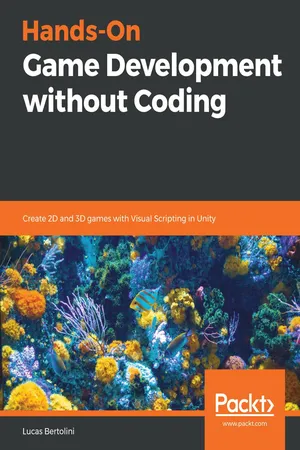
Hands-On Game Development without Coding
Create 2D and 3D games with Visual Scripting in Unity
Lucas Bertolini
- 430 pages
- English
- ePUB (mobile friendly)
- Available on iOS & Android
Hands-On Game Development without Coding
Create 2D and 3D games with Visual Scripting in Unity
Lucas Bertolini
About This Book
Develop your own games with Unity 2D/3D Game Kit and use it for your presentations, kids education, level design, game design, proofs of concept, or even just for fun!
Key Features
- Build your first ever video game using Unity 2D/3D Game kit
- Learn how to create game levels, adding props, giving behaviours to objects and working on gameplay
- Step by step instructions on creating your own AI enemy and interacting with it
Book Description
Hands-On Game Development without Coding is the first Visual Scripting book in the market. It was tailor made for a non programing audience who are wondering how a videogame is made.
After reading this book you will be able to develop your own 2d and 3d videogames and use it on your presentations, to speed up your level design deliveries, test your game design ideas, work on your proofs of concept, or even doing it just for fun.
The best thing about Hands-On Game Development without Coding is that you don't need any previous knowledge to read and understand the process of creating a videogame. It is our main focus to provide you with the opportunity to create a videogame as easy and fast as possible.
Once you go through the book, you will be able to create player input interaction, levels, object behaviours, enemy AI, creating your own UI and finally giving life to your game by building it.
It's Alive!
What you will learn
- Understanding the Interface and kit flow.
- Comprehend the virtual space and its rules.
- Learning the behaviours and roles each component must have in order to make a videogame.
- Learn about videogame development
- Creating a videogame without the need of learning any programming language
- Create your own gameplay HUD to display player and Enemy information
Who this book is for
This book is for anyone who is interested in becoming a game developer but do not posses any coding experience or programming skills. All you need is a computer and basic software interface knowledge.
Frequently asked questions
Information
Basic Concepts - Variables and Components
- Visual Scripting
- Data types and data visualization
- Objects and components
Visual Scripting



Data types and data visualization
- Choices: Choices are usually represented by enums in the editor. This gives you the option to choose between a predefined set of options:

- Text: Text is represented with a string in the editor. By clicking on the label and writing something, we will have the opportunity to show that text to the user:

- Numbers: Numbers are represente...